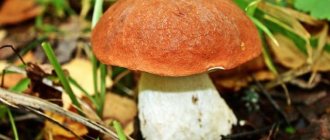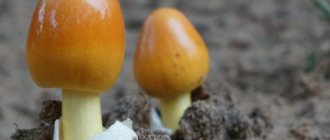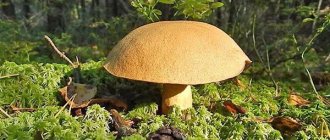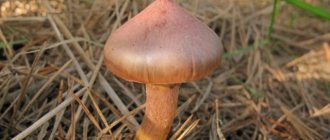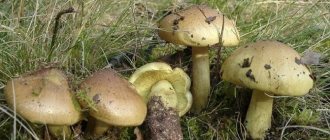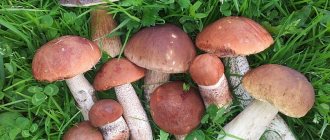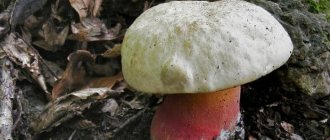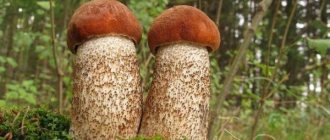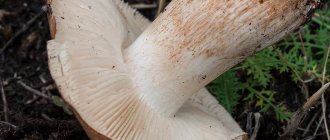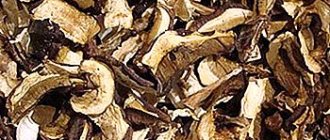Home Mushrooms
Among the most poisonous mushrooms, there are two types of toadstools: white and pale. Poisoning by both of them can be fatal, especially if the victim is not provided with emergency medical care within the first 24 hours. In order not to expose themselves and the lives of other people to such a risk, every mushroom picker should not only know what toadstools look like, but also have an idea of their specific distinctive features by which these mushrooms can be identified.
- 2 Poisonous mushroom toadstool: photo and description of the plant
- 3 How to distinguish toadstool from edible mushrooms
- 4 Signs of toadstool poisoning
What does it look like
Toadstool is a cap-footed mushroom. The young plant looks like an egg, completely covered with a film. The hat has a convex shape with smooth, slightly curved edges. Size and color change as the plant grows. On average, the diameter of the cap of an adult mushroom is 6-10 cm, although in some specimens it can reach 15 cm. The top is flat and smooth, the inner side is equipped with a lamellar layer. The color can vary from olive or green in young plants to pale in adults.
The body of the mushroom is white with a fleshy structure. The leg is thin, cylindrical in shape with a thickened base, 1-1.5 cm in diameter and 8-16 cm long. The ring on the leg is white, flat. In an adult plant it disappears. The color of the leg is whitish or matches the color of the cap. At the base there is a wide cup-shaped volva 3-5 cm wide. Most often, it goes half into the ground. The spores are round and white.
You can see in detail what the pale grebe looks like in numerous photographs that are in encyclopedic and other publications on relevant topics.
What does a pale grebe look like?
Characteristics of toadstool mushrooms
Pale toadstool is the official name of this mushroom, in Latin - Amanita phalloides. It is also popularly called the green fly agaric due to its belonging to this genus, color and toxicity. It is often found in forests and fields, summer cottages, and loves moisture. Because of its poison, it is dangerous to human life, so you need to learn to recognize it and never even pick it up.
Appearance and photo
The shape of the mushroom cap changes depending on age; it is ovoid in young mushrooms and becomes flat in mature mushrooms. The color range of the cap ranges from olive to gray and green; this metamorphosis also occurs during the growth of the fruiting body.
The hat is covered with a film on the outside, which is its distinctive characteristic, and has a fibrous structure. Its leg is cylindrical in shape and has a small diameter. Young mushrooms have a fringed ring that bursts over time. The leg and cap of the toadstool are mostly the same color, but the color of the leg may be lighter. Below are photos of the fetus in its natural environment for a detailed examination.
Morphology
This mushroom belongs to the fly agaric family and is classified by mycologists as poisonous. This is a small parasitic fruit with the following species differences:
- The cap is 5-15 cm in diameter, hemispherical in shape, straightens to flat as it grows. Color – olive, green, gray, in exceptional cases pale white. It has smooth edges and a film on top. Young mushrooms develop white warts on the surface, which disappear as the fruiting body ages.
- The leg is 8-16 cm high, up to 2 cm in diameter, cylindrical, straight, slightly widened at the base. It has a white dense ring, it does not grow to the Volva, which outwardly looks as if the stem and cap exist on their own. The color is pale, and may have a shade similar to a toadstool's cap.
- The fruit body is fleshy, light in color, which does not change when the toadstool is broken. The pulp is quite thin, having a pleasant smell in young fruits. In older people, the smell becomes sickly sweet.
- The plates are white and wide.
- The spore powder of this fungus is white, rounded spores reach a size of 7-8 microns.
This poisonous mushroom has a typical structure and upon careful examination it can always be recognized in the forest by the color of the cap and the shape of the stem.
Place of distribution
The habitat of the species in question is Eurasia; it chooses deciduous and broad-leaved forests of the temperate climate zone. Linden, oak, pine, and sphagnum moss are suitable for symbiosis. On the territory of Russia it can also be found almost throughout the entire territory, even in the taiga, but still the grebe prefers the southern regions and often chooses vegetable gardens and dachas as its place of growth. The green type of fly agaric chooses humus soils for life and growth.
Edibility
Pale toadstool is one of the most poisonous mushrooms in our climate zone; it not only causes poisoning when used in cooking, but its poison is also quickly absorbed by other fruiting bodies. Thus, upon contact (for example, in a mushroom picker’s basket) with green fly agaric, even good species become toxic.
Important!
All parts of the toadstool are poisonous, and heat treatment in the form of frying, boiling, as well as drying and soaking will not get rid of the poison. Toxic substances mainly affect the liver, kidneys, heart and blood of a person, subjecting them to fatal destruction.
Where does it grow
Amanita phalloides grows in deciduous and mixed forests of Eurasia, Asia and North America. Almost never found in coniferous forests. This is explained by the fact that the toadstool prefers fertile soils, and coniferous sandstones are not suitable for it. Most often, poisonous mushrooms can be found at the foot of oaks, hazels, beeches and birches.
They bear fruit regardless of whether they grow alone or in groups. Fruiting time is from August to November. This explains the fact that the mushroom is more common in August.
Where does it grow in Russia
The pale grebe in Russia grows in places with a temperate climate. Since it prefers fertile, moist soils, it can often be found not only in the forest or park, but also in garden plots.
Most often, the pale grebe is found in August.
A little history
The French biologist Sebastien Vaillant was the first to study Pallid Grebes. Subsequently, he gave the poisonous mushroom from the fly agaric family the name Amanita phalloides. If you look at the name, then in translation it combines two meanings at the same time. Amanita is a fly agaric, and phalloides, oddly enough, denotes male dignity - apparently it was with these aspects that the scientist came up with the Pale Toadstool.
Of course, not everywhere it was called exactly as most people were used to. For example, in 1727 in England it was nicknamed Death's Cap because of its strong poison, which can deprive a person of vitality even in small doses.
Variability of the pale grebe
The inedible mushroom is characterized by changeability: as it grows, the color of the cap changes to a darker one, and the flesh develops an unpleasant odor. This feature makes it similar to other mushrooms, which can be called its counterparts.
Related species: stinking fly agaric or white toadstool, spring fly agaric, amanita bisporigera and amanita ocreata.
They all belong to the same fly agaric family, and each species has its own distinctive characteristics. Animals can eat them, but they are deadly to humans.
Description
To avoid poisoning, it is best to follow the “golden rule”: do not pick mushrooms that you do not know. Even one poisonous mushroom that accidentally gets into the basket and is processed along with edibles can cause poisoning. Inedible and poisonous mushrooms, similar to edible ones, have distinctive characteristics.
Distinctive features: a cap with a diameter of 5 to 15 cm, at first bell-shaped, then slightly convex, silky, white, pale green, yellow-green or olive green; the color in the middle of the cap is usually darker - up to olive-brown, without flakes on the surface; the plates are white, the leg is up to 15 cm long, up to 2 cm thick, thickened at the base, white or greenish, with a membranous ring, with a sac-like vagina at the base; The pulp is white, without any particular smell or taste.
Where does it grow
The pallid grebe is found in abundance in places, especially in the southern zone of the forest zone, from June to October. Loves fertile soil, grows more often in mixed and deciduous forests among oaks, beech and hazel. Habitat: Europe, Asia and North America.
Seasonality: late summer – autumn.
Similar to champignon
Inexperienced mushroom pickers sometimes confuse toadstool with edible champignon. It must be remembered that the champignon, unlike the poisonous toadstool, has pink, light brown or blackish plates; there is no sac-like vagina at the base of the leg; the leg is shorter.
Similarity to green russula
Sometimes the pale toadstool is confused with the green russula. Russula does not have a thickening at the base of the stalk, and there is no membranous ring in the middle of the stalk.
Float mushrooms are smaller in size, have thinner flesh, and lack a ring.
Use in folk medicine
The toadstool mushroom is used in alternative medicine. Homeopaths use it in minimal quantities as a remedy for poisoning with inedible types of mushrooms.
However, this technique raises many concerns, since non-compliance with the dosage can be fatal.
Use of toadstool in oncology
Poisonous mushroom against cancer
German scientists conducted experiments on laboratory animals. They were injected with a toxic substance - amanitin, extracted from a mushroom. It was discovered that the poison, once introduced into a cancer cell, inhibits its growth. As a result, the malignant neoplasm disappears.
Through numerous experiments, it was possible to develop a technique that made it possible to treat cancerous tumors without causing additional harm to health. The poison not only destroyed cancer cells, but also prevented the development of metastases. To treat some types of cancer, just a few injections were enough. Despite the experience gained, doctors have not yet used this technique to treat people.
How to distinguish from edible mushrooms
In nature, there are many mushrooms that look like deadly ones. They can be found not only among poisonous, but also among useful specimens. All lovers of quiet hunting should know how to distinguish toadstools from edible mushrooms. Inexperienced mushroom pickers may confuse them and mistake them for edible species. Most often they can be confused with champignons, honey mushrooms, green or greenish russula, greenfinches or floats. To prevent this from happening, every mushroom picker, before going into the forest, should study the pale toadstool, a description of which is in many relevant publications.
Greenfinch mushroom
Greenfinch
The external structure of the greenfinch resembles a deadly mushroom. A distinctive feature is the color of the stem and cap. The edible mushroom has a pleasant lemon green color. In addition, its cap is straight with smooth edges, and not curved like a toadstool. The surface is smooth, the structure is dense and fleshy. In young specimens the cap is slightly convex, in mature specimens it is raised upward. The greenfinch has a short, strong leg, without a characteristic “skirt,” covered with small brown scales.
The greenfinch grows in the sandy soil of a coniferous forest. Toadstools are rarely found in such places. This circumstance can be considered the main difference between the two types of mushrooms.
Honey mushrooms
Toadstools are often mistaken for edible honey mushrooms. The mushrooms look similar. The legs of honey mushrooms have a small “skirt”. The color of the cap is pale sandy-brown. The main distinguishing feature of a useful specimen is the presence of scales on the cap, as well as the cream color of the plates and a pleasant smell.
False honey mushrooms, which belong to the inedible class, are rarely confused with toadstool. This variety does not have a ring on the stem, and the cap is bright brown.
What does champignon look like?
Champignon
Experienced mushroom pickers can easily distinguish an edible champignon from a poisonous mushroom, despite the external similarity of the legs.
Attention should be paid to the plates located under the cap. In champignon they are pink or brown, while in toadstool they are white.
The poisonous toadstool is more like a false champignon. Its leg is yellowish in color. And if you break the cap, yellow spots will appear along the edges of the break.
Green and greenish russula
The color and shape of the russula cap resembles a toadstool. Therefore, you cannot be guided by this sign when picking mushrooms. The main difference is the leg. In russula it is straight. There is no ring, volva or tuberous thickening on it. In addition, the edible specimen has a pleasant smell, unlike an adult poisonous mushroom, which smells unpleasant.
Float gray
Float
This edible mushroom is unattractive in appearance and looks like a toadstool. This feature often misleads even experienced mushroom pickers. The main difference can be considered the presence of a thin leg without a characteristic ring and a dirty gray cap with rough edges. When damaged, the color of the pulp does not change. In addition, the float is smaller in size. Lives in mixed or deciduous forests.
What can a poisonous mushroom be confused with?
The danger of mushrooms lies in their similarity to each other. So, many toxic forest fruits have edible counterparts, and the toadstool is no exception. Most often, inexperienced mushroom pickers confuse toadstool with champignons, green mushrooms and russula.
For this reason, it is important to know the distinctive characteristics of edible mushrooms so that dangerous forest fruits do not end up in your basket instead.
Important!
It is also important to remember about the filmy ring on the toadstool's leg, which is its distinctive feature and is absent in edible fruits.
Green row
The cap of the green grass, or greenfinch, has a characteristic rich olive color, which cannot be said about the toadstool. In addition, the edges of the cap of a poisonous mushroom look down a little and can become covered with a sticky coating, when on an edible mushroom they are absolutely straight and smooth.
How to get rid of toadstool in the garden?
If a toadstool appears in a garden, vegetable garden or other place on a personal plot, you need to remove it as quickly as possible in order to free the cultivated plants from the unwanted neighborhood. The toadstool must be uprooted and destroyed.
If a group of poisonous mushrooms is found, they should be pulled out. Then, to get rid of the mycelium, lift the top layer of soil and, if possible, remove the mushroom threads. If this is problematic, then leave the layer of earth raised for several days. The sun's rays will completely destroy the remnants of the fungal root system. Then dig up the place where they grew. If there are too many of them, then you will have to fight them with the help of special garden chemicals.
Pale toadstool needs to be uprooted
To prevent the future appearance of green fly agaric in the garden plot, you should clear the area of rotten and rotten wood. It is necessary to periodically remove weeds and tall grass from the area to avoid the appearance of dark, damp areas that poisonous mushrooms love. In those places where toadstool was once found, you need to periodically loosen the soil.
Symptoms and signs of poisoning
The danger of toadstool poisoning lies in the fact that the first symptoms of poisoning do not appear immediately, but after several hours. Evidence that there are toxic substances in the body will be the appearance of acute pain in the stomach and intestines, vomiting, diarrhea, and severe thirst. Diarrhea and vomiting will be so severe and frequent that even medications will not help stop them. Feces with diarrhea will be watery and yellow-green in color.
First symptoms of poisoning
The effect of poison on the human body
The effect of a poisonous mushroom on the human body can be divided into several stages.
- Latent or incubation period. Lasts 1-2 days after poisoning with toadstools. No signs of intoxication are observed during this period, however, toxic substances have already penetrated into the blood and begun their destructive effect.
- The first symptoms of intoxication. The fact that the body is poisoned is indicated by the appearance of acute pain, vomiting and diarrhea. The occurrence of unpleasant symptoms occurs against the background of inflammation of the intestinal and stomach mucous membranes caused by the penetration of toxins. During this period, a person suffers from severe dehydration, which provokes a drop in blood pressure. Severe weakness, dizziness, and convulsions occur. The person may lose consciousness. A similar picture is observed within 2 days.
- A period of imaginary calm. For some time, all symptoms of intoxication may disappear. The duration of this period is no more than 12 hours. The patient may have a false sense of quick recovery. But at this time, the poison that has entered the body continues its destructive effect, and if its dose was too large, sudden death may occur.
- Damage to internal organs. Toxins have a destructive effect on the liver, which can cause severe pain in the right hypochondrium. Symptoms resemble the development of renal failure. At this stage, the patient may develop yellowness of the skin, mucous membranes of the eyes and mouth.
Eating 1/3 of a mushroom cap poses a mortal danger to humans. When such an amount of poison enters the body, heart failure develops, the kidneys and liver are deeply affected, and death occurs as a result. Death can occur within 6-7 days, but if the victim does not receive the necessary assistance, he may die within the first day after poisoning.
Timely treatment allows you to get rid of signs of intoxication without a trace. Internal organs are restored after removing toxins.
Edibility
The pale grebe is deadly poisonous and is not used as food. Moreover, not only the body of the mushroom is poisonous, but even the mycelium and spores! Therefore, it is better not to collect berries, herbs and other mushrooms near the places where it grows.
With any processing - drying, frying, cooking, freezing and other possible and impossible processing, the poison does not lose its strength. A small piece is enough for poisoning to occur.
Symptoms of poisoning appear 8-12, and sometimes 20-40 hours after eating. Poison is insidious, since signs of poisoning occur when the human body is already severely poisoned. Mortality occurs in more than 50% of cases.
First aid for poisoning
In case of poisoning, the victim must be provided with assistance as quickly as possible. His life depends on it. When the first symptoms of poisoning appear, you must quickly rinse your stomach. The patient should be asked to drink at least 1 liter of clean water and induce vomiting by pressing with the fingers on the root of the tongue. The procedure is repeated at least 5-6 times. In addition, the patient can be offered to take sorbents that will accelerate the removal of harmful substances from the body. In this situation, those that need to be diluted with water before use are more suitable.
Qualified assistance for poisoning with toadstool
However, if several hours have passed since the moment of poisoning, then the poison has entered the blood. Simple gastric lavage in this situation will not be enough. It is necessary to call a medical team or take the victim to the hospital in another way to provide more qualified assistance in case of poisoning.
In a medical facility, gastric lavage will be performed using a tube, which is much more effective than a home procedure. Sorbents and laxatives will be prescribed. To restore a weakened body, the doctor will prescribe vitamin complexes, including vitamin C, as well as drugs that restore the microflora of the intestines and stomach.
